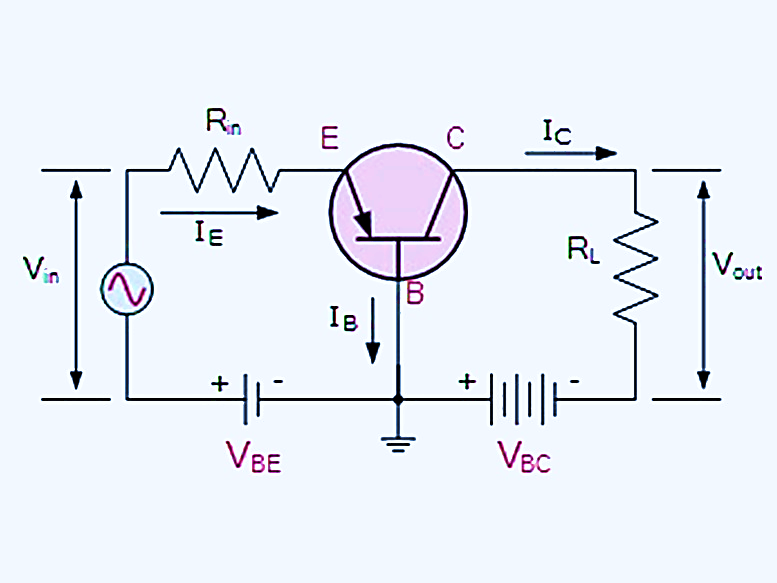
The collector current in a transistor circuit is $ 2.9mA $. If the base current is $ 100\mu A $. $ \alpha $ of the transistor is:
(A) 0.066
(B) 0.77
(C) 0.97
(D) 0.87
Answer
565.8k+ views
Hint
In a bipolar transistor, being operated in any of the three configurations.
It is always valid that:
Emitter current = Base current + collector current
$ \Rightarrow {I_E} = {I_B} + {I_C} $
Value of collector current and base current is given, find the value of emitter current from above.
Now, $ \alpha ({\text{current gain)}} = \dfrac{{{I_C}}}{{{I_E}}} $
Put the values of $ {I_C}{\text{ and }}{I_E} $ and get the value of $ \alpha $.
Complete step by step answer
When we join two PN junction diodes, back to back (p-p or n-n sides are joined) it forms a bipolar junction transistor.
Two types of bipolar transistor can be formed depending upon the sides joined.
PNP or NPN.
A transistor is a three-terminal device, and the three terminals are named Emitter(E), Collector(C) and Base(B).
Three configurations can be obtained by making any of the three terminals common.
The figure given below shows a PNP transistor circuit in Common base configuration.

As we can see in the figure, above that at junction B the emitter current is being divided into Base current and collector current.
Hence, we can say that:
Emitter current = Base current + collector current (it is valid for any of the configuration)
$ \Rightarrow {I_E} = {I_B} + {I_C}$
In the question it is given that,
${I_C} = 2.9mA$
And ${I_B} = 100\mu A = 100 \times {10^{ - 6}}A = 0.1 \times {10^{ - 3}}A = 0.1mA$
$\therefore {I_E} = 2.9 + 0.1 = 3mA$
Now, $\alpha $is the current gain, which is given by:
${\text{current gain}} = \alpha = \dfrac{{{I_C}}}{{{I_E}}}$
So, here $\alpha $will come out to be:
$\alpha = \dfrac{{2.9}}{3} = 0.9666 \approx 0.97$
Hence, (C) is the correct option.
Note
Whenever a unitless quantity (like $ \alpha $ ) is given by the ratio of the two similar quantities (like current in above question), always first make the two similar quantities of the same units (like above both the currents was converted to mA) otherwise their will be an error in the answer.
In a bipolar transistor, being operated in any of the three configurations.
It is always valid that:
Emitter current = Base current + collector current
$ \Rightarrow {I_E} = {I_B} + {I_C} $
Value of collector current and base current is given, find the value of emitter current from above.
Now, $ \alpha ({\text{current gain)}} = \dfrac{{{I_C}}}{{{I_E}}} $
Put the values of $ {I_C}{\text{ and }}{I_E} $ and get the value of $ \alpha $.
Complete step by step answer
When we join two PN junction diodes, back to back (p-p or n-n sides are joined) it forms a bipolar junction transistor.
Two types of bipolar transistor can be formed depending upon the sides joined.
PNP or NPN.
A transistor is a three-terminal device, and the three terminals are named Emitter(E), Collector(C) and Base(B).
Three configurations can be obtained by making any of the three terminals common.
The figure given below shows a PNP transistor circuit in Common base configuration.

As we can see in the figure, above that at junction B the emitter current is being divided into Base current and collector current.
Hence, we can say that:
Emitter current = Base current + collector current (it is valid for any of the configuration)
$ \Rightarrow {I_E} = {I_B} + {I_C}$
In the question it is given that,
${I_C} = 2.9mA$
And ${I_B} = 100\mu A = 100 \times {10^{ - 6}}A = 0.1 \times {10^{ - 3}}A = 0.1mA$
$\therefore {I_E} = 2.9 + 0.1 = 3mA$
Now, $\alpha $is the current gain, which is given by:
${\text{current gain}} = \alpha = \dfrac{{{I_C}}}{{{I_E}}}$
So, here $\alpha $will come out to be:
$\alpha = \dfrac{{2.9}}{3} = 0.9666 \approx 0.97$
Hence, (C) is the correct option.
Note
Whenever a unitless quantity (like $ \alpha $ ) is given by the ratio of the two similar quantities (like current in above question), always first make the two similar quantities of the same units (like above both the currents was converted to mA) otherwise their will be an error in the answer.
Recently Updated Pages
Master Class 12 Business Studies: Engaging Questions & Answers for Success

Master Class 12 Economics: Engaging Questions & Answers for Success

Master Class 12 English: Engaging Questions & Answers for Success

Master Class 12 Maths: Engaging Questions & Answers for Success

Master Class 12 Social Science: Engaging Questions & Answers for Success

Master Class 12 Chemistry: Engaging Questions & Answers for Success

Trending doubts
What are the major means of transport Explain each class 12 social science CBSE

Which are the Top 10 Largest Countries of the World?

Draw a labelled sketch of the human eye class 12 physics CBSE

How much time does it take to bleed after eating p class 12 biology CBSE

Explain sex determination in humans with line diag class 12 biology CBSE

Differentiate between homogeneous and heterogeneous class 12 chemistry CBSE




